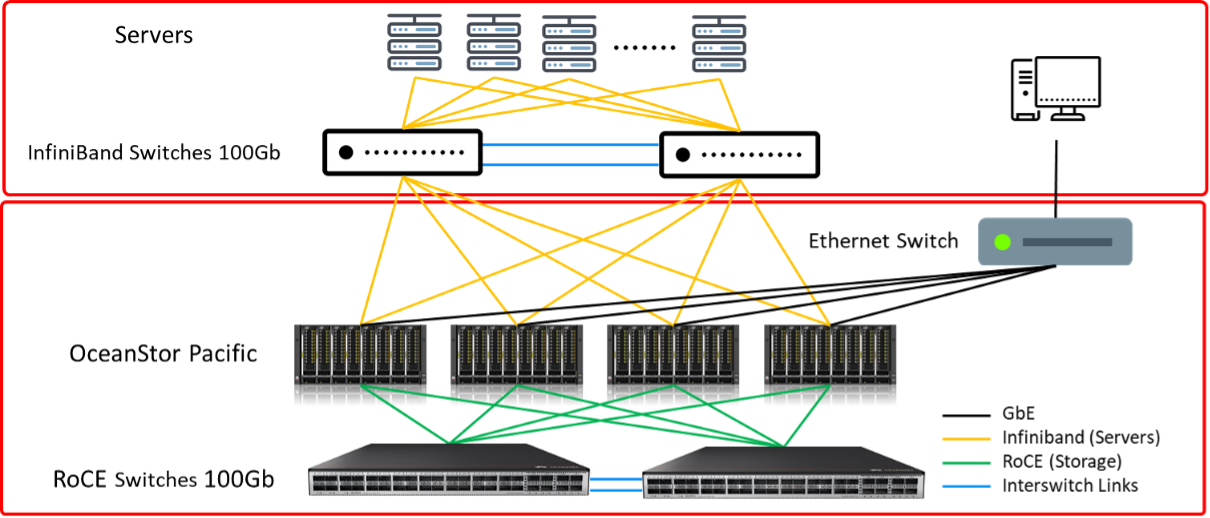
Brought to you by:
Enterprise Strategy Group | Getting to the Bigger Truth™
ESG TECHNICAL VALIDATION
Huawei OceanStor Pacific Next-gen HPDA Storage
By Tony Palmer, Senior Validation Analyst
JUNE 2021
Abstract
The Challenges
Figure 1. Data-intensive Applications, Tools, and Solutions Deployed
Which of the following types of data-intensive applications, tools, and/or solutions does your organization currently have deployed or intend to deploy within the next 12 months? (Percent of respondents, N=310, multiple responses accepted)
Source: Enterprise Strategy Group
The Solution: Huawei OceanStor Pacific Next-gen HPDA Storage
Figure 2. Huawei OceanStor Pacific Next-gen Parallel File System

Source: Enterprise Strategy Group
Figure 3. Huawei OceanStor Pacific Next-gen Models
Source: Enterprise Strategy Group
ESG Tested
Multi-protocol Support
Figure 4. The Test Environment

Source: Enterprise Strategy Group
| Components | Description | Quantity |
|---|---|---|
| OceanStor Pacific 9950 | Disks: 10x3.84TB NVMe SSD, RAM: 128 GB Network: 100 Gigabit InfiniBand | 4 |
| Hosts | Huawei RH2288H V5 x86, CPU: 2* Xeon Gold 6151, RAM: 256GB, OS: CentOS 7.6 | 11 |
| Front-end (Server) Switches | Mellanox SB7800 Managed EDR InfiniBand Switch | 2 |
| Back-end (Storage) Switches | Huawei CloudEngine 8850-64CQ-EI | 2 |
Source: Enterprise Strategy Group
Figure 5. Multi-protocol Access
Source: Enterprise Strategy Group
ESG confirmed that the files were identical after accessing and downloading to each of the four clients, then checking the MD5 hashes against the one recorded at the source system. Next, more files were created in the shared directory by each of the four clients using a prefix matching their protocol. Search queries were able to quickly find all the files that were created across all protocols ( Figure 6).
Figure 6. Metadata Search
Source: Enterprise Strategy Group
Figure 7. Huawei OceanStor Pacific Write Bandwidth
Source: Enterprise Strategy Group
Figure 8. Huawei OceanStor Pacific Read Bandwidth
Source: Enterprise Strategy Group
Hybrid Workload Testing
Figure 9. Huawei OceanStor Pacific Write Bandwidth
Source: Enterprise Strategy Group
Figure 10. Huawei OceanStor Pacific Read Bandwidth
Source: Enterprise Strategy Group
High-density Design and TCO
Figure 11. TCO Analysis of the OceanStor Pacific Next-gen Storage System
Source: Enterprise Strategy Group
Why This Matters
The Bigger Truth
This ESG Technical Review was commissioned by Huawei and is distributed under license from ESG.
1 Source: ESG Master Survey Results, The State of Data Analytics, Aug 2019.
2 Source: ESG Research Report, 2021 Technology Spending Intentions Survey, Jan 2021.
3 Source: ESG Research Report, Data Storage Trends in an Increasingly Hybrid Cloud World, Mar 2020.
4 Source: ESG Research Report, Data Storage Trends in an Increasingly Hybrid Cloud World, Mar 2020.
6 Source: ESG Research Report, Data Storage Trends in an Increasingly Hybrid Cloud World, Mar 2020.
7 Ibid.
All trademark names are property of their respective companies. Information contained in this publication has been obtained by sources The Enterprise Strategy Group (ESG) considers to be reliable but is not warranted by ESG. This publication may contain opinions of ESG, which are subject to change from time to time. This publication is copyrighted by The Enterprise Strategy Group, Inc. Any reproduction or redistribution of this publication, in whole or in part, whether in hard-copy format, electronically, or otherwise to persons not authorized to receive it, without the express consent of The Enterprise Strategy Group, Inc., is in violation of U.S. copyright law and will be subject to an action for civil damages and, if applicable, criminal prosecution. Should you have any questions, please contact ESG Client Relations at 508.482.0188.

Enterprise Strategy Group | Getting to the Bigger Truth™
Enterprise Strategy Group is an IT analyst, research, validation, and strategy firm that provides market intelligence and actionable insight to the global IT community.